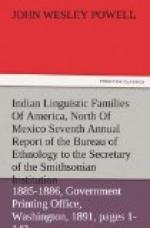[Footnote 68: U.S. Expl. Exp., 1846, vol. 6, pp. 630, 633.]
It was not until 1856 that the distinctness of the linguistic family was fully set forth by Latham. Under the head of Moquelumne, this author gathers several vocabularies representing different languages and dialects of the same stock. These are the Talatui of Hale, the Tuolumne from Schoolcraft, the Sonoma dialects as represented by the Tshokoyem vocabulary, the Chocuyem and Youkiousme paternosters, and the Olamentke of Kostromitonov in Baeer’s Beitraege. He also places here provisionally the paternosters from the Mission de Santa Clara and the Vallee de los Tulares of Mofras; also the language Guiloco de la Mission de San Francisco. The Costano containing the five tribes of the Mission of Dolores, viz., the Ahwastes, Olhones or Costanos of the coast, Romonans, Tulomos and the Altahmos seemed to Latham to differ from the Moquelumnan language. Concerning them he states “upon the whole, however, the affinities seem to run in the direction of the languages of the next group, especially in that of the Ruslen.” He adds: “Nevertheless, for the present I place the Costano by itself, as a transitional form of speech to the languages spoken north, east, and south of the Bay of San Francisco.” Recent investigation by Messrs. Curtin and Henshaw have confirmed the soundness of Latham’s views and, as stated under head of the Costanoan family, the two groups of languages are considered to be distinct.
GEOGRAPHIC DISTRIBUTION.
The Moquelumnan family occupies the territory bounded on the north by the Cosumne River, on the south by the Fresno River, on the east by the Sierra Nevada, and on the west by the San Joaquin River, with the exception of a strip on the east bank occupied by the Cholovone. A part of this family occupies also a territory bounded on the south by San Francisco Bay and the western half of San Pablo Bay; on the west by the Pacific Ocean from the Golden Gate to Bodega Head; on the north by a line running from Bodega Head to the Yukian territory northeast of Santa Rosa, and on the east by a line running from the Yukian territory to the northernmost point of San Pablo Bay.
PRINCIPAL TRIBES.
Miwok division: Olamentke division: Awani. Olowidok. Bollanos. Chauchila. Olowit. Chokuyem. Chumidok. Olowiya. Guimen. Chumtiwa. Sakaiakumni. Likatuit. Chumuch. Seroushamne. Nicassias. Chumwit. Talatui. Numpali. Hettitoya. Tamoleka. Olamentke. Kani. Tumidok. Olumpali. Lopolatimne. Tumun. Sonomi. Machemni. Walakumni. Tamal. Mokelumni. Yuloni. Tulare. Newichumni. Utchium.
Population.—Comparatively few of the Indians of this family survive, and these are mostly scattered in the mountains and away from the routes of travel. As they were never gathered on reservations, an accurate census has not been taken.




